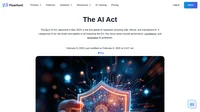Overview of the AI Act’s Risk Framework
The European AI Act introduces a groundbreaking regulatory system for artificial intelligence. This system uses a risk-based approach to ensure that AI systems are deployed safely, transparently, and ethically. A key part of this system is dividing AI systems into four clear risk categories: Unacceptable Risk, High Risk, Limited Risk, and Minimal or No Risk. Each category outlines the level of regulation and oversight needed, based on how the AI might affect safety, fundamental rights, or societal values.
The risk pyramid in the Act categorizes AI systems as follows:
- Unacceptable Risk: AI systems that clearly threaten safety, fundamental rights, or European Union values are banned. Examples include AI used for social scoring, manipulative practices, or specific biometric identification tools.
- High Risk: AI systems that significantly affect safety or rights, such as those in healthcare, law enforcement, or education, must comply with strict regulations.
- Limited Risk: Systems in this category, such as chatbots, have specific transparency requirements that ensure users know they are interacting with AI.
- Minimal or No Risk: These include applications like AI-powered spam filters or video games, which do not require heavy regulation because of their low risk of harm.
This structured system ensures that regulations match the potential risks of an AI system, balancing safety and ethics with technological innovation.
Where Chatbots Fit: Limited Risk and High-Risk Categories

Limited Risk Chatbots
Most chatbots fall under the Limited Risk category in the European AI Act. These systems are commonly used across various industries for tasks like customer support, retrieving information, or providing conversational interfaces. They are considered to have a lower potential for harm compared to more impactful AI systems. However, even in this category, providers must follow transparency rules. They must clearly inform users that they are interacting with an AI system. Some examples include:
- Customer Support Bots: These bots, often seen on e-commerce websites, help users by giving product recommendations or responding to questions. Providers must disclose that users are communicating with AI.
- Informational Chatbots: These are used by government bodies or organizations to share public information, and they are required to state their AI nature.
High-Risk Chatbots
In some cases, chatbots can fall into the High Risk category if their use significantly affects critical rights or safety. Examples of such chatbots include:
- Healthcare Chatbots: AI systems that provide medical advice or psychological counseling can influence important health decisions, requiring strong regulatory oversight.
- Financial Advisory Bots: Chatbots offering financial advice or evaluating creditworthiness can impact users’ economic opportunities. These systems must meet stricter compliance standards.
- Legal-Aid Chatbots: AI tools that assist with legal advice or help in court cases can affect justice outcomes, placing them in the High Risk category.
Chatbots in this category must adhere to strict requirements, including detailed documentation, risk assessments, and human oversight to prevent harmful consequences.
Examples of Chatbot Use Cases in Each Category
Limited Risk Examples:
- Retail Chatbots: Assisting users with searching for products or tracking orders.
- Travel Assistance Bots: Providing updates on flights or suggesting hotel options.
- Education Chatbots: Offering answers to general questions about courses or schedules.
High-Risk Examples:
- Mental Health Chatbots: Offering therapy or supporting users in crisis situations.
- Recruitment AI: Screening job candidates or influencing hiring decisions.
- Judicial Assistance Bots: Helping with legal defense or preparing legal documents.
By classifying chatbots based on their use cases and potential risks, the European AI Act ensures that regulations are specifically tailored to protect users while supporting the development of AI-powered conversational tools.
Compliance Requirements for Chatbot Providers
Transparency Obligations for Limited-Risk Chatbots
Under the European AI Act, chatbots classified as Limited Risk must follow specific transparency rules to ensure ethical and responsible use. Providers are required to inform users that they are interacting with an artificial intelligence system rather than a human. This allows users to make informed decisions during their interaction with the chatbot.
For instance, customer service chatbots on e-commerce platforms must clearly state, “You are now chatting with an AI assistant,” to avoid confusing users. Similarly, informational chatbots used by government agencies or educational institutions must also disclose their AI nature to ensure clear communication.
These transparency obligations are enforceable and aim to build trust while protecting users from potential manipulation or deception. Transparency remains a key part of the AI Act, encouraging accountability in how AI systems, including chatbots, are used across different sectors.
Compliance for High-Risk Chatbots: Documentation and Oversight
Chatbots categorized as High Risk are subject to much stricter compliance requirements under the European AI Act. These systems are often found in areas where they can significantly affect users’ fundamental rights or safety, such as healthcare, finance, or legal services.
Providers of High-Risk chatbots must establish a thorough risk management system. This includes:
- Robust Documentation: Providers need to keep detailed records about the chatbot’s design, purpose, and functionality. These records allow regulatory authorities to assess whether the chatbot complies with ethical and legal standards.
- Data Quality Assurance: High-Risk chatbots must use high-quality datasets to reduce biases and inaccuracies. For example, a chatbot offering financial advice must rely on accurate and impartial data to prevent unfair outcomes.
- Human Oversight: Providers must ensure proper human oversight to prevent harmful results. This means human operators should have the ability to intervene, override, or adjust the AI system’s decisions when needed.
- Risk Assessments: Providers are required to perform regular risk assessments to identify and address potential harms. These assessments should account for both the chatbot’s operational risks and its broader societal impacts.
Failing to meet these requirements can lead to severe consequences, including fines and reputational harm, as outlined in the AI Act’s enforcement measures.
General Principles: Fairness, Accountability, and Non-Discrimination
In addition to specific requirements, the European AI Act outlines general principles that all chatbot providers must follow, regardless of their risk level. These principles include:
- Fairness: Providers must ensure that chatbots do not discriminate against users based on factors like gender, ethnicity, or socioeconomic status.
- Accountability: Providers are held responsible for a chatbot’s actions, outcomes, and compliance with the AI Act. They must also maintain systems for receiving and addressing user feedback.
- Non-Discrimination: Chatbots need to be designed and tested to avoid biases that could result in unfair treatment of users. For example, recruitment chatbots must ensure their algorithms do not disadvantage candidates based on irrelevant criteria.
Following these principles helps chatbot providers align with the AI Act’s standards for ethical and trustworthy artificial intelligence. These rules protect users while also supporting innovation by creating clear and consistent guidelines for AI deployment.
The compliance framework for chatbot providers under the European AI Act is both thorough and necessary. By fulfilling these requirements, providers contribute to a safer and more equitable AI environment while avoiding significant penalties for non-compliance.
Deadlines for Compliance with the European AI Act
The European AI Act provides a clear timeline for organizations to adjust their AI systems, including chatbots, to meet new regulations. These deadlines help chatbot providers prepare to meet legal requirements and avoid penalties.
Timeline for Limited Risk Chatbots
Chatbots classified as Limited Risk, which represent most chatbot applications, must follow specific rules for transparency and operations by the given deadlines. The first deadline is February 2, 2025, when transparency requirements for Limited Risk AI systems take effect. Providers must inform users when they are interacting with an AI system. For example, customer service chatbots need to display disclaimers like, “You are interacting with an AI assistant.”
By August 2, 2025, further governance rules will apply. These include assigning national authorities to oversee compliance and implementing updated transparency and accountability guidelines. Providers also need to establish internal systems for periodic evaluations as required by the Act.
Deadlines for High-Risk Chatbots and General AI Systems
High-Risk chatbots, which are used in areas such as healthcare, finance, or legal services, have stricter compliance deadlines. The first deadline for High-Risk AI systems is February 2, 2025, when initial rules for risk management systems and data transparency must be in place. Providers need to prepare detailed documentation, ensure high-quality data, and set up processes for human oversight by this date.
The final deadline for full compliance is August 2, 2027, which applies to all High-Risk AI systems operational before August 2, 2025. By this date, providers must complete risk assessments, establish procedures for human intervention, and ensure their systems are free from discriminatory biases.
Implications of Missing Compliance Deadlines
Failing to meet these deadlines can lead to serious consequences, such as fines of up to €30 million or 6% of the provider’s global annual turnover, whichever is higher. Non-compliance could harm a provider’s reputation, result in a loss of user trust, and reduce market share. Additionally, providers may face the suspension of AI-related activities within the European Union, which can disrupt business operations.
Adhering to deadlines also offers benefits. Providers who meet compliance requirements early can build trust with users and partners, which may strengthen their reputation and encourage long-term loyalty.
The phased approach of the European AI Act allows chatbot providers enough time to adjust their systems to the new regulations. However, careful planning and meeting deadlines are necessary for ensuring compliance and maintaining operations within the European market.
Implications and Penalties for Non-Compliance
The European AI Act introduces strict penalties for organizations that fail to follow its rules. These penalties aim to ensure compliance and encourage ethical and transparent AI practices. Breaking these regulations can result in financial losses and harm to an organization’s reputation and market standing.
Fines and Financial Penalties
The European AI Act enforces heavy financial penalties for non-compliance, organized into levels based on the seriousness of the violation. The largest fines apply to breaches involving banned AI practices, such as systems that manipulate behavior or exploit vulnerabilities. These violations can lead to administrative fines of up to €35 million or 7% of the company’s global annual revenue, whichever is higher.
For violations linked to high-risk AI systems, such as chatbots used in healthcare, law enforcement, or financial services, the fines are slightly lower but still significant. Companies can face penalties of up to €15 million or 3% of their global annual turnover, depending on the type of breach. These breaches include failures in risk management, insufficient human oversight, or using biased or low-quality data.
Even smaller violations, like providing incomplete or false information to regulatory authorities, can result in fines of up to €7.5 million or 1% of annual turnover. The Act also considers the financial capacity of small and medium-sized enterprises (SMEs), applying lower fines to ensure fairness.
These penalties are higher than those under the General Data Protection Regulation (GDPR), showing the EU’s dedication to making the AI Act a global standard for AI regulation.
Reputational Risks for Chatbot Providers
Non-compliance can also cause significant harm to an organization’s reputation. Companies that fail to meet the European AI Act’s requirements may face public criticism, lose customer trust, and become less competitive. Users are increasingly valuing transparency and ethical AI practices, so any failure to comply can damage credibility.
For chatbot providers, this could mean reduced user engagement and weaker brand loyalty. Organizations that rely heavily on AI-driven customer service may lose users if they fail to disclose that customers are interacting with AI systems or if their chatbots behave unethically or show bias.
Regulators may also publicly report cases of non-compliance, increasing reputational damage. This exposure can discourage potential business partners, investors, and stakeholders, hurting the organization’s growth and stability over time.
Benefits of Early Compliance
Meeting the European AI Act’s compliance requirements early can bring several benefits. Organizations that adjust their operations to meet the Act’s standards before deadlines can avoid fines and establish themselves as leaders in ethical AI practices. Early compliance shows a dedication to transparency, fairness, and responsibility, which appeals to both consumers and regulators.
For chatbot providers, early compliance can build user trust and loyalty. Being transparent, like informing users that they are interacting with AI, improves customer satisfaction. Additionally, addressing bias and using high-quality data enhances chatbot performance, leading to a better user experience.
Organizations that comply early may also gain a competitive advantage. They are more prepared for future regulatory changes and can build trust and credibility in the market. This can open new opportunities for growth, partnerships, and collaboration.
The consequences of not complying with the European AI Act are substantial. Financial penalties, harm to reputation, and operational challenges are real risks for organizations. However, proactive compliance offers clear benefits, enabling chatbot providers to avoid fines and create a trustworthy, ethical, and user-focused AI environment.
Create AI Chatbot with AI agents
Build AI chatbots with FlowHunt's tool-calling agents. Automate tasks, enhance interactivity, and integrate advanced tools for seamless operations!




